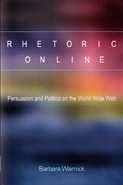In this chapter, Warnick unpacks the theoretical grounding for the chapters that follow, each of which builds on the foundation she lays here. That foundation combines a broad Burkean definition of rhetoric as language used to induce cooperation among human beings with a media theory approach that is sensitive to the characteristics of the Web as qualitatively different from older media (25). The particular characteristics of the Web on which Warnick focuses are "nonlinearity, differential access, instability, and dispersion" as manifested in five parts of the communication process: "reception, source, message, time, and space" (27).
Warnick contends that these characteristics affect how persuasion on the Web is created, perceived, and responded to; as a result, it is only through a robust understanding of all of these vectors that rhetorical theory and criticism can best analyze Web-based public discourse.
Reception
While there are always exceptions, it is generally true that Western print conventions and audiences trained in those same conventions participate in a logic of linearity. Of course, one can open a book anywhere and read forward and backward from any page, but the intended and expected path is from a designated start to a designated finish. Although Web artifacts are often created and experienced using the conventions of print, the reading practices made possible (indeed, encouraged) by hypertext challenge linearity as the principle structuring design and reception.
The changes in reading practices that the Web brings forth, Warnick contends, mandate adaptations in rhetorical theory and criticism, which has typically used source- or text-based approaches that, while useful for many purposes, tend to pay relatively little attention to the audience's role in co-creating meaning. Users' opportunity to "talk back to" some Web texts, while never completely unfettered, creates (at least for sites that archive comments) the chance for rhetorical critics to engage in what Warnick calls "the grounded study of user reaction," a type of study that can reap dividends from reader-response criticism (32). Even when primary evidence of Web site audience response is not available, Warnick calls for an expansion in critical methods to account for "the ways in which the Web site text prestructures user response through placement of internal and external hyperlinks, intertextual allusions, opportunities to interact with on-site content, and [makes use of] recognizable cultural contexts and intertexts that shape the reader's interpretation" (32).
